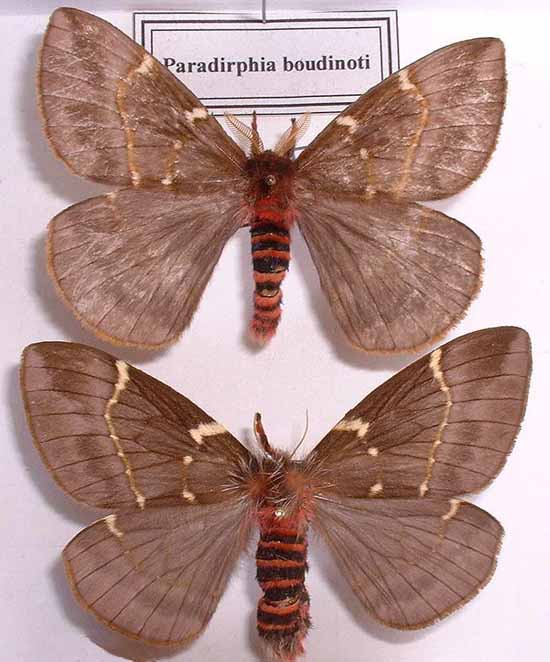Paradirphia boudinoti
|
|
Updated as per Lemaire's Hemileucinae 2002, July 16, 2006
Updated as per An annotated list of the Lepidoptera of Honduras, 2-29-2012, Jacqueline Y. Miller; March 3, 2013
Updated as per ENTOMO-SATSPHINGIA Jahrgang 3 Heft 4 12.08.2010; September 9, 2014
|
Paradirphia boudinoti
pah-ruh-DIRF-ee-uhMbaw-DIN-oh-eye
Lemaire & Wolfe, 1990

TAXONOMY:
Superfamily: Bombycoidea, Latreille, 1802
Family: Saturniidae, Boisduval, [1837] 1834
Subfamily: Hemileucinae, Grote & Robinson, 1866
Tribe: Hemileucinae, Grote & Robinson, 1866
Genus: Paradirphia Michener, 1949
|
MIDI MUSIC
"Someone to Watch
Over Me"
copyright C. Odenkirk
MIDI CITY
ON.OFF
<bgsound src="watch.mid" LOOP=FOREVER>
|
DISTRIBUTION:
Paradirphia boudinoti
(wingspan: males: 64-67mm; females: 76mm)
flies in
Mexico: Coahuila, Tamaulipas,
San Luis Potosi, Hidalgo, Puebla. It has been taken at elevations from 1127-1700m.
I suspect it is also in Nuevo Leon, Queretaro and Tlaxcala, but I have no confirmed reports for those states.
Jacqueline Y. Miller reports it in Honduras, so it would probably also be in Guatemala.
This species seems to favour drier areas of northeastern and central Mexico. Like P. coprea it has the yellow cell spot on ventral surface in each of all
four wings, but on the hindwing the spot is more off-white and more comma-shaped than circular and orange-yellow as in coprea.
P. semirosea lacks the yellow ventral cell spots.

Paradirphia boudinoti male, 66mm, San Luis, Mexico,
on my home computer only.

Paradirphia boudinoti male (verso), 66mm, San Luis, Mexico,
on my home computer only.
FLIGHT TIMES AND PREFERRED FOOD PLANTS:
Larvae feed on
Malus, Prunus and Robinia pseudoacacia.
ECLOSION, SCENTING AND MATING:
Females extend a scent gland from the tip of the abdomen,
and the night-flying males pickup and track the airbourne pheromone plume with their well-developed antennae.
EGGS, LARVAE, COCOONS AND PUPAE:
Eggs are deposited in clusters
on hostplant foliage.
Paradirphia boudinoti larvae are highly gregarious and have
the urticating spines typical of larvae from the Subfamily
Hemileucinae.
Larval Food Plants
It is hoped that this alphabetical listing followed by the common
name of the foodplant will prove useful. The list is not exhaustive.
Experimenting with closely related foodplants is worthwhile.
Malus
Prunus
Robinia pseudoacacia.....
|
Apple
Cherry
Black locust/False acacia
|
Use your browser "Back" button to return to the previous page.
Return to Paradirphia Genus
Return to Mexican and Central American Saturniidae Directory
Return to Main WLSS Index
The pronunciation of scientific names is
troublesome for many. The "suggestion" at the top of the page is
merely a suggestion. It is based on commonly
accepted English pronunciation of Greek names and/or some
fairly well accepted "rules" for latinized scientific names.
The suggested pronunciations, on this page and on other pages,
are primarily put forward to assist those who hear with internal
ears as they read.
There are many collectors from different countries whose
intonations and accents would be different.
Some of the early describers/namers chose genus
and species names indicating some character of the insect, but more
often, they simply chose names from Greek or Roman mythology or
history.Those species names which end in "ensis" indicate a
specimen locale, and those which end in "i", pronounced "eye", honour
a contempory friend/collector/etc.
I do not know the source of the genus
name "Paradirphia" chosen by Michener in 1849, but it
probably has to do with the similarity of these moths to those
in the genus Dirphia.
The species name "boudinoti" is honourific for Boudinot.

| 
Support this website and visit other insect sites by
clicking flashing butterfly links to left or right.
|

|
Use your browser "Back" button to return to the previous page.




